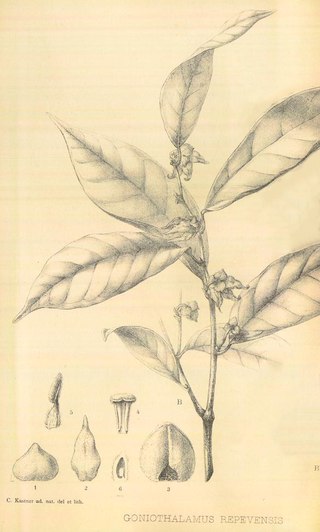
Aglaia lawii is a species of tree in the family Meliaceae. As well as the autonym species, there are two subspecies accepted.
Aglaia leptantha is a species of tree in the family Meliaceae. It is found in Mainland and Island Southeast Asia. People use the plant for food, incense, and for human and bovine medicine. Gibbons also eat parts of the tree.

Campylospermum serratum is a plant in the family Ochnaceae. The specific epithet serratum is from the Latin meaning "with teeth", referring to the leaf margin. It is found in Tropical Asia, from Sulawesi, Indonesia to Hainan, Zhōngguó/China and over to southwestern India. Gomphia serrata was a previous common name for the species. The plant is used for it wood and its sap is used in folk medicine and in the past for teeth-blackening.
Mitrella mesnyi is a botanical scientific name that may refer to:

Sphaerocoryne lefevrei, known in Khmer as rumduol/rumdul (រំដួល) and in Thai as lamduan (ลำดวน), is a flowering plant of the Annonaceae family, native to Southeast Asia. It is commonly cultivated as an ornamental plant, and is the national flower of Cambodia and the provincial flower of Thailand's Sisaket province. Some sources treat it as the same species as the similar S. affinis.

Goniothalamus repevensis is a species of plant in the family Annonaceae. It is native to Cambodia, Laos and Thailand. Achille Eugène Finet and François Gagnepain, the French botanists who first formally described the species, named it after Mt. Knang-Repeuh in Cambodia where Jean Baptiste Louis Pierre collected the lectotype specimen they examined.
Goniothalamus tamirensis is a species of plant in the family Annonaceae. It is native to Cambodia, Laos, Peninsular Malaysia, Thailand and Vietnam. The French botanists J.B. Louis Pierre and François Gagnepain, who first formally described the species, named it after the region in Cambodia it was collected from, which they record as “monts Tamir”.
Pinanga sylvestris is a species of tree in the Arecaceae, or palm tree, family. It grows 2-6 m tall, sometimes in bundles, shade tolerant, from Meghalaya (India) to Thailand, Cambodia, Vietnam, Laos and Zhōngguó/China. In Thailand it is recorded in the Khao Soi Dao Wildlife Sanctuary, in Chanthaburi Province, as a very common mid-storey tree in the Quercus semiserrata-dominated rainforest at 1,400 to 1,540 m. In Cambodia it occurs uncommonly in coastal vegetation communities, but is common in dense and semi-dense evergreen rainforest in the lowlands and at moderate altitude. The palm grows in similar dense and semi-dense communities in Laos and Vietnam. On the mountain of Ngọc Linh in Quảng Nam Province of Vietnam, it dominates the ground layer of low montane broadleaf evergreen forest, that occurs from 150 to 1000m.
Part of a group, the subfamily Calamoideae, whose members are usually called rattans in English, Calamus godefroyi, is a climbing plant, and part of the Arecaceae, or palm, family.
Calamus bousigonii, is a liana, a climbing plant, and part of the Arecaceae, or palm, family. It is a member of the subfamily Calamoideae, whose members are usually called rattans in English,
Brownlowia emarginata is a slightly climbing tree, a member of the family Malvaceae. It occurs in Vietnam, Cambodia, Laos and Thailand.
Ardisia helferiana is a species of flowering plant in the genus Ardisia in the family Primulaceae. Growing as a shrub, it occurs in Mainland Southeast Asia. The plant is used for food, fuel and medicine.
Combretum trifoliatum is a vine of the family Combretaceae. It is found from Myanmar across Southeast Asia and Wallacea to New Guinea and Australia. It grows in wet places, including where it can be submerged for four months a year by floodwaters. It is unusual in retaining its photosynthesizing leaves when flooded. Parts of the plant are used in traditional medicine.
Memecylon caeruleum is a shrub or tree species in the Melastomataceae family. It is found from New Guinea, west through Southeast Asia to Tibet, Zhōngguó/China. It has become an invasive weed in the Seychelles. It has some local use for wood and food.
Pantadenia adenanthera is a shrub in the Euphorbiaceae family. It is found in parts of Southeast Asia. The species is used for its wood and edible fruit.
Stixis obtusifolia is a shrub or liana in the Resedaceae family. It is found in parts of Southeast Asia. The wood is used as fuel, the leaves as a tea.
Strychnos nux-blanda is a shrub or small tree in the Loganiaceae family. It is native to Southeast Asia and Assam. The wood is used as fuel; seeds are toxic, but used in folk-medicine. It is one of the plants featured in the garden of King Narai (1633–88) at Lopburi, Thailand.

Xanthophyllum lanceatum is a tree in the Polygalaceae family. It grows across Southeast Asia from Sumatera to Bangladesh. The leaves are used as a hops-substitute in beer making and the wood as fuel. Fish in the Mekong regularly eat the fruit, flowers and leaves.
Wurfbainia vera is a herbaceous plant in the Zingiberaceae family. Formerly called Amomum verum, it was the first plant species to be named by a woman, the Scots artist Elizabeth Blackwell in 1757. The Kingdom of Siam obtained the fruit (seeds) of the plant from Cambodia in the 18th century to export as a spice to China and Europe. As well as Cambodia the species is found in Sumatra, Thailand and Vietnam. The young leaf, the fruit and the seeds are edible, the seeds are known as Siam cardamom in English.

Uvaria dulcis is a species of woody climber in the Annonaceae family. It is found in tropical Asia, in a disjunctive distribution, eastern Indonesia, Jawa, and then Mainland Southeast Asia. The plant has an edible fruit, which in Khmer language has the colourful name triël dâhs krabéi.





